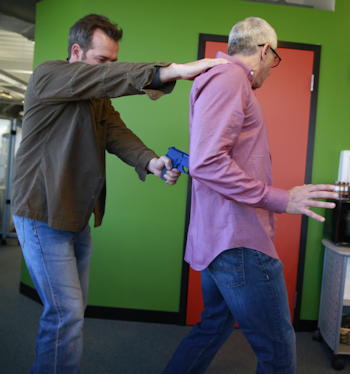About Rampage & Spree Killings
 At 7 AM (August 20th, 1986) part-time postal worker Patrick Sherrill, turned up for work at the Edmonton Post Office, armed with three handguns and
a backpack of ammunition – he had one motive, which was to kill as many of his co-workers, supervisors, and managers as he could. His rampage lasted
all of 15 minutes and ended with 14 dead and six wounded; his last act was to shoot himself. Sherrill had proved himself to be a “lethal employee”.
Although there had been other active shooter incidents previously, Sherrill brought the fear of rampage killings into the workplace. The idea that
a co-worker could “go postal” and go on a killing spree against co-workers had never really been thought about or imagined before. Pat Sherrill’s rampage made this threat/danger a reality.
At 7 AM (August 20th, 1986) part-time postal worker Patrick Sherrill, turned up for work at the Edmonton Post Office, armed with three handguns and
a backpack of ammunition – he had one motive, which was to kill as many of his co-workers, supervisors, and managers as he could. His rampage lasted
all of 15 minutes and ended with 14 dead and six wounded; his last act was to shoot himself. Sherrill had proved himself to be a “lethal employee”.
Although there had been other active shooter incidents previously, Sherrill brought the fear of rampage killings into the workplace. The idea that
a co-worker could “go postal” and go on a killing spree against co-workers had never really been thought about or imagined before. Pat Sherrill’s rampage made this threat/danger a reality.
Pat Sherrill was a difficult employee, who had received numerous reprimands concerning misdirected mail and poor performances, from various supervisors - including Richard Esser, who was one of his victims. Many of the warning signs that things were not right with Patrick Sherrill were there, but nobody k new how to connect them in a way that would paint a picture of a ticking time-bomb that was just waiting to go off. When we interview somebody for a job, we rarely ask ourselves whether the person who is sitting before us is a dangerous individual. Our concerns are about their ability to do the job we’re hiring them to do. When a supervisor judges an employee’s poor performance, their sights are set on finding ways to improve it, not on whether the individual’s actions and behaviors are signals of something darker. The questions we ask, are designed to find out and discover specific answers. If we don’t ask questions pertaining to workplace safety, it is unlikely that we will discover any information regarding it, via our other questions.
 Pat Sherrill was known in his community and workplace as “Mad Pat” – when one employee heard the shots (they didn’t believe it was actual shooting,
mistaking it for fireworks), they made the joke, that it was probably Pat coming back to shoot the supervisor who had reprimanded him the day previously.
He was known as a man who tortured and killed animals (a very definite warning sign when it comes to killers), and had a fascination and obsession with
guns. His odd behaviors, and obvious/apparent anger, made people nervous and fearful of this loner, who had been unable to hold down any of his previous
jobs for any length of time. The warning signs were there, but they were discounted or turned into dark-humored jokes. The correct questions asked at
interview would have easily have identified Pat Sherrill as a dangerous employee, however they weren’t (and rarely are) asked.
Pat Sherrill was known in his community and workplace as “Mad Pat” – when one employee heard the shots (they didn’t believe it was actual shooting,
mistaking it for fireworks), they made the joke, that it was probably Pat coming back to shoot the supervisor who had reprimanded him the day previously.
He was known as a man who tortured and killed animals (a very definite warning sign when it comes to killers), and had a fascination and obsession with
guns. His odd behaviors, and obvious/apparent anger, made people nervous and fearful of this loner, who had been unable to hold down any of his previous
jobs for any length of time. The warning signs were there, but they were discounted or turned into dark-humored jokes. The correct questions asked at
interview would have easily have identified Pat Sherrill as a dangerous employee, however they weren’t (and rarely are) asked.
Most workplace killers don’t just suddenly exhibit extreme behaviors, they build up to them, often making implicit or explicit threats, either to co-workers or management. Oftentimes, people don’t take these threats/statements seriously, believing that the person saying them is either joking or talking big. There is normally a “trigger” event which sends them over the top, in Pat Sherrill’s case it was the reprimand he received the day previously, for Omar Thornton, it was being asked to resign.
Like Pat Sherril, Omar Thornton was a troublesome employee, who worked in a warehouse owned by Hartford Distributors (a beer distribution company). On August 3rd 2010, Thornton was asked to come in for a disciplinary hearing over some surveillance footage which had caught him stealing beer – he’d also been implicated in the theft of empty kegs. At the hearing, he was given the option of being either fired or resigning; he chose the latter and signed the resignation letters. Before he was escorted from the building, he pulled two Ruger SR9 semiautomatic pistols from his lunchbox and started shooting his former co-workers. Within the first few minutes, Thornton had killed 8 people. The Police turned up several minutes later, but by then Thornton had barricaded himself inside an office, and after calling his mother, shot himself. Thornton claimed that he had been the victim of racial abuse, at the hands of fellow co-workers, though he never made any complaint to union officials regarding this, and other workers belonging to minority groups claimed that, although most workers at the distribution center were white, there were no racial tensions, etc. We will never know what the real motivation behind the shootings was, but it was the disciplinary hearing which acted as the trigger.
Sometimes a trigger occurs because of a safety policy that a company puts in place. In 1988, Laura Black filed for a restraining order against Richard Farley; something her company ESL Incorporated advised/pressured her into doing. Black and Farley had been co-workers for ESL Inc, for about four years; a period which saw Farley engage in a stalking campaign against Black, which included sending around 200 letters to her (roughly one a week), along with turning up at her yoga class, and leaving presents on her desk, etc. Towards the end of 1985 (about 18 months into the campaign), Black approached the ESL Human Resources Department for help. ESL demanded that Farley attend counselling sessions, before eventually terminating his employment in 1986. Not only had his stalking activities continued, but he was aggressive with other co-workers, and was under-performing in his job. Although he began working for another company (Covalent Systems Corporation), he continued to stalk Laura Black – he claimed he had fallen in love with her the moment they met. His activities including phoning her, and harassing her at work. The Human Resources Department at ESL, started to pressure Laura Black into getting a restraining order against Farley. Initially she resisted, as she’d come to understand how Farley reacted and responded to things and she was worried that it might push him towards violence (in his exit interview at ESL, Farley had been quite explicit about violent measures he was prepared to take, but none of his threats were taken seriously), but she became worried that if she didn’t do as they asked, her career progression at ESL might be stunted. On February 2, 1988, she was granted a temporary restraining order against Farley, which was due to be made permanent on February 17th.
The temporary restraining order didn’t prevent Farley from purchasing firearms, and he equipped himself with a variety of weapons, including a Mossberg 12-guage pump action shotgun. On February 16th (the day before the court hearing that would make the restraining order permanent), he drove to the ESL building, having first dropped off a package with his attorney, containing documents which he believed showed that he and Black were engaged in a long-term relationship. He later claimed his intention was to wait for Laura Black to leave, and convince her not to proceed with the restraining order. He arrived at the building at about 3:00 pm, put on a bullet-proof vest and ear plugs, and approached the building, shooting bystanders - before entering a side door by shooting out the glass. He headed to Laura Black’s office, shooting employees as he went (the fact that he had over 1000 rounds of ammunition on him, suggests that this was intended as a mass-shooting, rather than simply an assassination attempt on Laura Black). When he got to Black’s office and opened the door, she slammed it back in his face. Enraged, he shot through the door with his shotgun, hitting Black in the shoulder and sending her to the ground unconscious – she suffered a collapsed lung. Farley then moved on, shooting and killing other ESL employees. Farley continued his rampage for another 5 hours, holding SWAT teams at bay by moving from room to room, before eventually giving himself up (Laura Black and some other employees managed to escape during this time).
To the company, a restraining order seemed a logical next step and a solution to ending Farley’s stalking campaign. Despite everything that had happened in the past, they believed him to be rational, and hoped for him to respond logically to the restraining order. An individual who continues a stalking campaign for four years, against a person who rejects every one of their advances, is not behaving in a rational manner, and to believe that they would respond in the correct fashion to a restraining order, is naïve at best. Laura Black knew how Farley would respond (not in the exact manner, but she knew it would be an emotional reaction, not a rational one), and had reservations about seeking the restraining order, and only complied with her company’s request when she had concerns about her career advancement if she didn’t. It would be wrong to accuse ESL of causing the shooting, however it must be acknowledged that their lack of understanding concerning stalkers and Farley’s character helped facilitate the crime. There are some areas where Humans Resources simply don’t have the expertise to deal with a situation – their understanding is a legal, not a behavioral one.
A company or enterprise is created with one primary goal; to sell products and services. This goal colors all others e.g. employees are selected/chosen based on their ability to help achieve this goal. Rarely does employee safety exist as a priority (most employees see fire drills as an inconvenience, that interrupts their work), and yet it should. Companies should provide a safe environment for those who work for them, and this involves dealing with difficult employees in a manner that doesn’t put others at risk. Interview processes can be modified, adapted, or extended, to identify candidates with potentially dangerous personality types. Exit interviews and terminations can be handled in a way that reduces the chances of adverse reactions/responses, employees can be taught how to deal with different types of workplace aggression and violence, including active shooter scenarios, etc. For more information on seminars, courses and training programs that deal with different types of workplace violence, including active shooters/killers, please click here.
Location
Krav Maga Yashir
165 New Boston St (Unit E)
Woburn, MA 01801
Active Shooter Boston Instructor
Gershon Ben Keren

Subscribe
Sign up with your email address to receive news and updates.